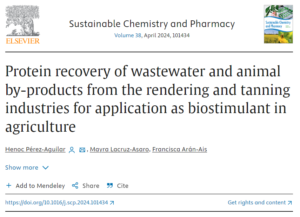A scientific paper related to the Life Superbiodiesel project was approved this month, named “Protein recovery of wastewater and animal by-products from the rendering and tanning industries for application as biostimulant in agriculture.”
This paper brings innovative technological solutions for biostimulant extraction in regenerative agriculture, a highly topical field due to its potential contribution to the sustainable and circular bioeconomy promoted by the European Union. Enzymatic hydrolysis, a more sustainable and versatile process that adds value to the final product, is used in their obtainment. Once raw materials were prepared and their suitability for this process was determined, protein hydrolysates were obtained for their application as a biostimulant based on free amino acids. In their validation, these proved an improvement in Chinese cabbage and lettuce seeds growth by 17-39%.
Their contribution to the circular bioeconomy is significant. In the conventional nitrogen life cycle, animal proteins penetrate the soil, where they interact with soil bacteria, decompose the protein, and produce organic nitrogen. This organic nitrogen is later converted into nitrates (nitrification), which is absorbed by plant roots. Plant leaves later transform those nitrates into vegetal amino acids and finally, into vegetal proteins. These vegetal proteins are consumed by livestock, digested, and converted once again into animal protein, completing the nitrogen life cycle.
Regarding sustainability, it should be kept in mind that the production process of these biostimulants has a significantly smaller carbon and water footprint (over six times smaller) as compared to inorganic fertilizers (Pérez-Aguilar et al., 2022), traditionally used in agriculture.
These results are available in the subscription-based scientific journal “Sustainable Chemistry and Pharmacy” that, as the name suggests, focuses on sustainable, green and biocircular chemistry and pharmacy. Available through this DOI (Digital Object Identifier).







Comments are closed.